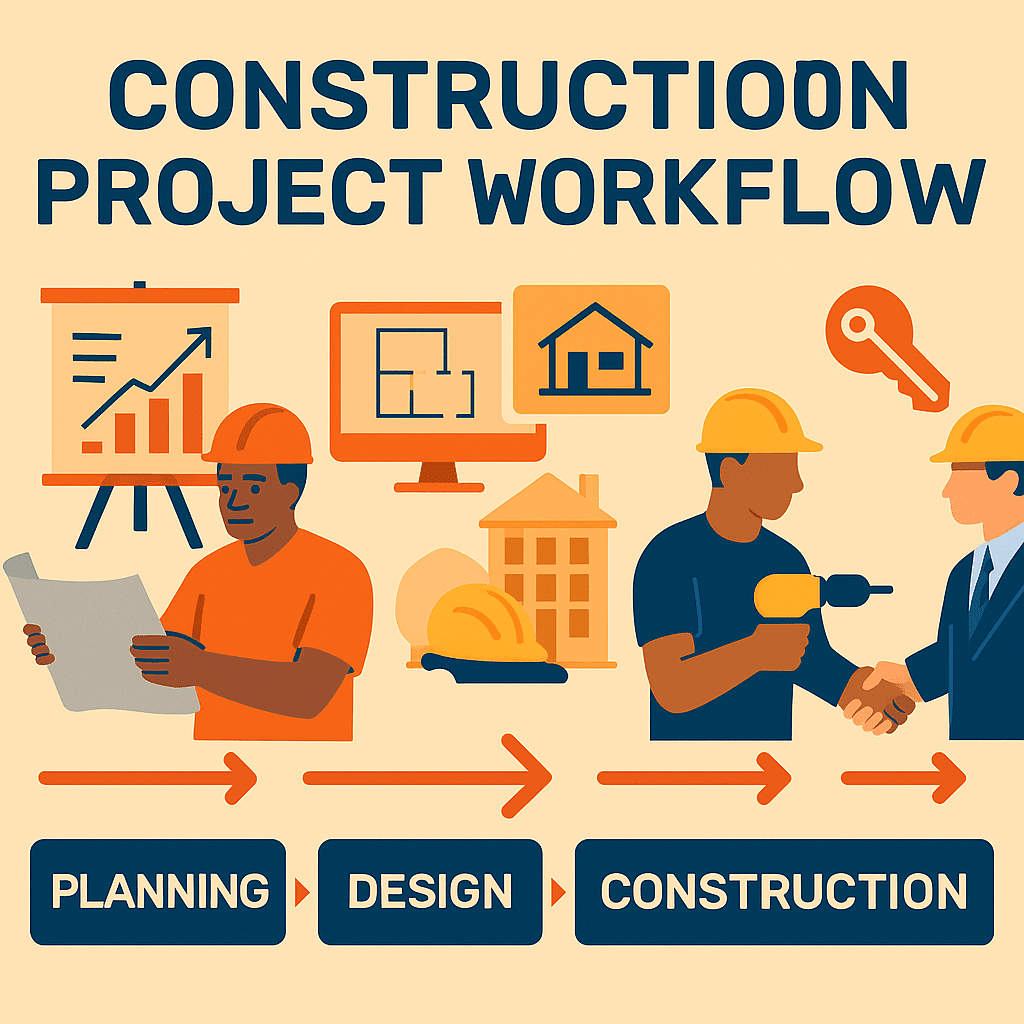A well-defined construction project workflow is no longer a luxury — it’s a necessity. In today’s complex building environment, UK builders face tight deadlines, rising material costs, labour shortages, and increasingly demanding clients. Without a structured process in place, projects can quickly spiral into delays, disputes, or even financial loss.
Yet, many builders still rely on ad hoc systems or outdated tools, moving from estimate to handover without clearly defined steps. This not only increases the risk of overruns but also damages client trust and profit margins. That’s why establishing a transparent, repeatable, and tech-driven construction project workflow is critical for success in the modern UK building industry.

From accurate cost estimation and legal contracts to digital planning and smooth handovers, every stage plays a vital role. The best workflows create accountability, reduce errors, and keep everyone — from subcontractors to clients — on the same page.
In this guide, we’ll walk through every phase of the construction project workflow, explaining:
- What happens at each step
- Which tools can make life easier
- How to avoid the most common pitfalls
We’ll also link to helpful resources from BuilderExpert and trusted UK authorities to give you practical, actionable insights.
Whether you’re a seasoned contractor, a first-time builder, or a project manager looking to optimise operations, this article will show you how to master the construction project workflow — from estimate to completion.
📊 Stage 1: Estimating the Project — Setting the Foundation for Success
The construction project workflow always begins with a strong estimate. This is the moment you lay the financial groundwork — and it can make or break everything that follows.
A good estimate isn’t just a ballpark figure. It’s a detailed, data-backed breakdown of expected labour, materials, plant, and overheads. For UK builders, it must also account for fluctuating supplier prices, subcontractor rates, and the latest regulatory requirements. A rushed or vague estimate can lead to underbidding, disputes, or budget blowouts later.
Why Accurate Estimating Is Crucial
Inaccurate estimates are one of the most common reasons projects go over budget. A detailed estimate anchors the construction project workflow, allowing for accurate scheduling, clear communication, and proper cash flow planning. Without it, you’re guessing — and guesswork is expensive.
According to The Access Group, up to 60% of construction professionals admit that they’ve lost profit due to inaccurate estimating. This highlights the need for tools and systems that ensure accuracy from day one.
Tools to Support Better Estimating
At BuilderExpert, we’ve developed tools specifically to support this stage of the construction project workflow:
- Basic Estimate: Ideal for quick quotes on smaller jobs or when you’re competing for a client’s attention.
- Detailed Estimate: Designed for full-scale residential and commercial projects with line-by-line breakdowns.
- BoQ Estimates: Crucial when working with architects, developers, or councils who demand a formal Bill of Quantities.
These estimates incorporate real-time pricing updates (see: Real-Time Construction Estimating Software), helping you avoid outdated figures or supplier shocks halfway through the build.
Common Mistakes at This Stage
- Underestimating Labour Costs: Always allow for skill-based rate differences and overtime scenarios.
- Vague Scoping: Be as detailed as possible. If a client says “new kitchen,” does that include appliances, tiling, or just cabinets?
- Skipping Subcontractor Input: Don’t assume — get real quotes for specialist tasks like roofing or electrics.
- Failing to Include Contingency: Include a contingency percentage based on project type and client risk tolerance.
Real-World Example
A builder quoting a loft conversion in South London used BuilderExpert’s estimating software and realised their original quote missed £4,500 in scaffolding and structural steel — just because they were copying an old Excel file. The software’s built-in construction project workflow flagged this as a gap in the BoQ, saving them from a costly oversight.
✍️ Stage 2: Quoting and Client Approval — Turning Estimates Into Agreements
After estimating comes the quoting phase. This step transforms the initial cost forecast into a formal proposal that the client can review, approve, and sign off on. It’s one of the most critical links in the construction project workflow, because it sets client expectations and formalises the scope of work.
A quote isn’t just about the numbers — it’s about clarity, communication, and confidence.
The Role of the Quote in the Construction Project Workflow
The quote defines:
- The exact scope of work (with exclusions clearly listed)
- The timeline and expected start/finish dates
- The payment schedule and deposit amount
- The terms and conditions
This is your opportunity to build trust. A professional, transparent quote reassures clients that they’re working with someone reliable — especially in a market where rogue builders are still a concern.
BuilderExpert’s quoting system ensures consistency between your estimates and final quotes, avoiding errors that can crop up when copy-pasting between documents.
👉 See also: Professional Builder Quotes – How to Price Like a Pro
Fixed Price vs Cost Plus Contracts
The quote also determines what type of contract you’ll use. Fixed price and cost-plus are the two most common structures, and choosing the right one is essential to maintaining healthy profit margins.
- In fixed-price contracts, the builder takes the risk — if costs go over, the builder absorbs the loss.
- In cost-plus contracts, the client pays actual costs plus a markup — but this can create tension if trust isn’t solid.
Learn more: Fixed Price vs Cost Plus Contracts – What’s Best for Your Project?
Whichever you choose, your quote needs to reflect it.
Tools That Support This Stage
BuilderExpert provides PDF-ready quoting templates that are fully aligned with your initial estimate. This means you can convert an estimate into a quote with just a few clicks, including:
- Optional cover page for a polished presentation
- Line-by-line breakdowns for transparency
- Client signature box and payment terms section
These tools streamline the construction project workflow, keeping your documentation clear, consistent, and client-friendly.
Real-World Example
A residential builder in Leeds used BuilderExpert to send a detailed quote for a rear extension. The clarity of the scope helped the client understand exactly what was and wasn’t included. The client said, “We got three quotes. Yours was the most professional — and the only one that told us what to expect if we wanted underfloor heating added later.” That transparency helped win the job.
📝 Stage 3: Contracts and Legal Documentation — Setting the Rules of Engagement
Once the quote is approved, the next stage in the construction project workflow is to lock everything down legally. A clear, enforceable contract protects both the builder and the client, and it sets the tone for how the project will be managed moving forward.
Why Contracts Matter in the Construction Project Workflow
Too many disputes in construction arise from unclear terms, vague scopes, or verbal agreements gone wrong. That’s why a written contract — tailored to the specific job — is essential. It ensures everyone is on the same page before the first brick is laid.
At this stage, your contract should include:
- The final scope of work as per the approved quote
- Milestones and payment schedules
- Change order procedures
- Warranties and aftercare
- Responsibilities around site access, insurance, and health and safety
👉 Internal link: Construction Payment Schedule: What’s Fair?
Types of Construction Contracts
In the UK, the most common contract types include:
- JCT Homeowner Contracts (for smaller residential projects)
- Federation of Master Builders (FMB) Contracts
- Custom agreements drafted with legal input
Each contract type supports different segments of the construction project workflow. For example, JCT contracts offer standardised clauses that help streamline dispute resolution, while custom agreements might be better for unique or high-value projects.
Using Digital Tools to Manage Contracts
In the digital age, contracts don’t have to be paper-based. BuilderExpert users can upload, store, and track client contracts securely on the platform. This allows for easy reference, quick updates, and cloud-based collaboration with legal teams or subcontractors.
Many UK builders are also integrating contract management software with their estimating tools — so the figures, milestones, and terms are auto-synced, avoiding manual errors.
External resource: GOV.UK: Construction Industry Scheme (CIS)
Best Practices
- Always include a variation clause – this allows you to bill for scope changes without renegotiating the entire contract.
- Include a termination clause – define what happens if the project is paused or cancelled.
- Be clear about what is not included – this reduces disputes later.
A strong contract is the legal anchor of your construction project workflow. It provides structure, protects your business, and reinforces professionalism.
📋 Stage 4: Planning and Project Preparation — Turning Vision into Action
Once contracts are signed, it’s time to mobilise. Planning is the bridge between paperwork and physical execution — a crucial part of the construction project workflow where clarity, coordination, and foresight are everything.
What Happens During Project Planning?
The planning phase involves transforming the contract and quote into an actionable strategy. It’s where the theoretical becomes practical. Key activities at this stage include:
- Developing a project timeline or Gantt chart
- Allocating tasks to subcontractors and internal teams
- Procuring materials and arranging deliveries
- Creating site setup plans, including storage, utilities, access, and security
- Finalising health and safety documentation (RAMS)
🔗 Internal link: See how BuilderExpert breaks down tasks with our Construction Estimate Tasks Breakdown
How Digital Tools Enhance Planning
Effective planning requires precise coordination. Many UK builders are turning to digital platforms like BuilderExpert’s Construction Estimating Software BEX to generate work breakdown structures, assign tasks, and automate alerts when schedules shift.
For example, if your electrician is running behind by two days, your planning software should be able to recalculate downstream impacts and notify all affected parties. This kind of visibility is essential to keeping your construction project workflow on track.
Procurement Planning
Material delays are one of the biggest causes of project setbacks. A smart construction project workflow anticipates lead times and manages stock proactively. Digitised procurement logs, preferred supplier lists, and integration with live pricing (as offered in BuilderExpert’s Real-Time Construction Estimating tools) can keep your material costs and availability under control.
🔗 Internal link: Real-Time Construction Estimating Software
External resource: CIOB Guide to Project Planning
Risk Management and Compliance
This is also the time to identify risks (weather, legal, financial) and mitigation strategies. Site inspections, insurance coverage checks, and compliance reviews must be completed before work begins.
It’s no exaggeration to say: poor planning = project failure. An accurate plan aligned with the quote and contract is the linchpin of a smooth construction project workflow.
🔨 Stage 5: Construction Execution – Managing the Build On-Site
With planning in place, the boots hit the ground. This is the phase where the construction project workflow becomes tangible — walls go up, materials are installed, and progress is visible. But execution isn’t just about bricks and mortar; it’s about coordination, supervision, and adaptability.
Site Setup and Daily Operations
Before the build begins, the site must be secured and prepared. This includes:
- Installing site hoarding, signage, and welfare facilities
- Setting up power, water, and access routes
- Holding pre-start briefings and toolbox talks
- Confirming RAMS (Risk Assessments and Method Statements) with every contractor
A well-organised site launch sets the tone for a smooth construction project workflow. It reduces errors, improves morale, and ensures everyone knows their responsibilities from day one.
Monitoring Progress
Daily check-ins and weekly site meetings are essential. BuilderExpert users can monitor real-time progress using integrated Gantt charts and digital site logs. Features like live budget tracking, change order management, and on-site photo documentation can streamline every aspect of execution.
🔗 Internal link: BuilderExpert’s Real-Time Construction Estimating Software
🔗 Internal link: Construction Estimate Tasks Breakdown
This phase is where delays, substitutions, or design changes often occur. A solid digital system ensures that all changes are properly documented and reflected in the project estimate and profit forecast. The more integrated your tools, the more reliable your construction project workflow.
Site Safety and Compliance
Safety is not optional. The Health and Safety Executive (HSE) conducts frequent inspections of UK construction sites. Your workflow should include:
- Daily safety checks
- Incident reporting procedures
- Continuous training and compliance documentation
🔗 External link: UK HSE – Construction Safety Regulations
Builders who prioritise safety enjoy smoother inspections, fewer injuries, and a more motivated workforce — all essential to a well-executed construction project workflow.
Real-World Example
One BuilderExpert client managing a £2.8 million commercial retrofit used our dashboard to log over 150 tasks and 18 subcontractors. Through real-time updates, they avoided a six-day electrical delay by fast-tracking deliveries — saving £12,000 in liquidated damages and preserving their profit margin.
🏁 Stage 6: Handover and Aftercare – Closing the Loop on the Construction Project Workflow
The build may be complete, but the construction project workflow doesn’t end when the last nail is hammered in. A successful handover phase ensures clients are satisfied, documentation is complete, and the groundwork is laid for aftercare, referrals, and future work.
The Practical Completion Phase
At this point, a formal inspection (often a snagging list) is conducted with the client or their representative. Tasks during this stage include:
- Rectifying any remaining defects
- Verifying all systems (plumbing, HVAC, electrical) are operational
- Cleaning and preparing the property for occupancy
- Conducting a final walk-through and obtaining client sign-off
You must also supply all compliance documentation such as:
- Building control approval
- Fire safety certificates
- EPC (Energy Performance Certificate)
- Warranties and guarantees
An effective construction project workflow includes a handover checklist that leaves nothing to chance.
🔗 Internal link: Detailed Construction Estimate
Digital Handover Tools
BuilderExpert enables you to attach all close-out documents to the project dashboard. Clients can access these digitally — no more lost manuals or missed warranty deadlines. This builds trust and sets you apart as a modern, professional builder.
🔗 External link: GOV.UK – Building Regulations Completion Certificates
Aftercare and Maintenance
Many builders stop engaging once the job is done — a mistake. The final part of your construction project workflow should include:
- Scheduled follow-ups (30-day and 12-month defect inspections)
- Prompt resolution of warranty issues
- Offering maintenance packages (where applicable)
Keeping clients happy after completion builds your reputation, leads to referrals, and opens the door to future upgrades or extensions.
Real-World Example
A self-builder in Kent reported their builder offered a “digital care pack” via BuilderExpert. It included warranties, product manuals, and a two-year maintenance calendar. Not only did it secure a glowing review, but the same client later hired the builder for a loft conversion — all because of a strong finish to the construction project workflow.
✅ Conclusion: Mastering the Construction Project Workflow for Long-Term Success
Understanding and refining your construction project workflow is no longer optional — it’s a competitive advantage. In a market where clients expect transparency, efficiency, and professionalism, builders who deliver a seamless process from estimate to handover will stand out.
Let’s recap the core stages:
- Estimating – setting accurate foundations with tools like our Basic Estimate and Detailed Estimate.
- Quoting – transforming your estimate into a professional, fixed-price or flexible builder quote that clients can trust.
- Contracting – locking down terms with clear payment schedules, using our article on construction payment schedules as your guide.
- Planning – allocating resources, breaking down tasks, and getting digital with our construction estimating software.
- Building – managing the job site with real-time tools, accurate Bill of Quantity (BoQ) control, and up-to-date pricing.
- Handover and Aftercare – delivering a polished finish, building client loyalty, and closing the loop on the construction project workflow.
BuilderExpert is designed to support every part of this journey — combining digital tools with smart workflows to help UK builders work faster, quote better, and win more work.
🔗 Want to see a full Construction Estimate Example? Check out how it all ties together.
The Bigger Picture
The construction project workflow is evolving. Clients are savvier, regulations are tighter, and competition is fiercer. Builders who embrace digital tools, clear documentation, and structured workflows will lead the next generation of UK construction professionals.
Whether you’re quoting your first job or scaling a growing firm, BuilderExpert gives you the clarity and control to handle every stage with confidence.
Let your next project start — and finish — stronger.
Master the construction project workflow from start to finish.

